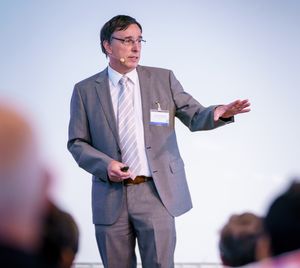KANBrief 3/19

Professor Dr Joachim Breuer was Director General of the German Social Accident Insurance (DGUV) from 2002 to 2019. Besides other functions, he is now President of the International Social Security Association (ISSA) and the Club de Genève – Global Social Future in Switzerland. At the 2019 EUROSHNET Conference in Dresden, he ventured a look at the future world of work in the age of 4.0 and globalization.
We‘re already starting to see what tomorrow‘s world of work is going to look like. A lot of people are talking about the networking of production processes as if it were something for the future, even though networking, Industry 4.0 and collaborative robots are already the norm in many companies. But the pace with which these things are changing is often underestimated. Technological progress is driving change and the emergence of new vocations. The World Economic Forum estimates that of the children who are now at primary school, around two-thirds will work in vocations that do not even exist at present. By the same token, a considerable number of existing jobs and vocations will disappear over the next twenty years.
The growing automation of routine tasks will make a whole swathe of professions redundant, or transform them radically. Unskilled workers are not the only ones affected. Bookkeepers, call-centre agents and even highly qualified personnel such as radiologists will have to adapt, since automated processes will increasingly impinge upon established areas of work.
Digitalization may also influence the race between standardization and technical development, because a new runner is out of the starting blocks, namely cybersecurity. It‘s too early to say conclusively whether hacking and cybercrime are problems that need to be addressed by standardization. I believe that in the future, we‘ll increasingly have to deal with risks posed by the behaviour of third parties, in the form of attacks involving malicious code, or simply as a result of incorrect user behaviour. This is all the more reason to ask whether a product can be described as safe when attention has been paid to its functional safety, but not to the possibility of unanticipated interventions in the software. In the face of such scenarios, it hardly seems appropriate to talk of safety without mentioning security.
Artificial intelligence – AI for short – galvanizes people, but also polarizes them. It presents us with new challenges and can provide a major boost to technical development. AI, though, is not always associated with creative effort; often, it merely results in processes becoming faster. Last year, a team of researchers in the USA found a way of using big-data analyses and machine-learning algorithms to accelerate research into new superalloys. They increased the speed of the work by a factor of 200.
Accelerating processes on this scale will soon yield a wealth of new products and applications. But how will we know whether they are also safe? Artificial intelligence can detect natural laws and phenomena that no human being has anticipated or intuited. That‘s the huge advantage of AI. At the same time, it‘s also its drawback: AI can produce errors without anyone knowing why.
The changes and disruptions that are emerging won‘t just affect companies and business models. If the pace of change increases, it will have consequence for institutions, the social partners, and other parties who up to now have also been setting the pace.
We must also ask whether standardization will still be able to make the same contribution to workplace safety and health as it has up to now. In Germany, we‘ve been examining for a long time whether standardization can keep pace with innovation. It‘s attempting to adapt to the growing speed of technical progress. Specifications that are no longer produced fully by consensus, such as DIN SPECs, are one consequence of this development.
A further aspect is that in the future, changes in industrial processes are unlikely to originate in Europe and the USA, as has been the case up to now. The shift in the focus of economic power on our planet is well underway. It‘s therefore crucial for standardization to establish powerful networks in order to be taken seriously as a competitor on the track. In short: the race will present us with exciting tasks.